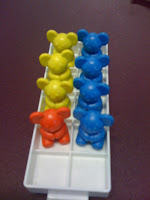Subitising
Definition: Instantly recognizing the number of objects in a small group, without counting.
Subitising is when children are able to recognise an amount by seeing the total without counting. For example, if three flowers are drawn on the board the child that can subitise is able to instantly see three instead of saying “1, 2, 3.” This form of recognition can be encouraged through the use of practise. The teacher may represent varying amounts of an object on the board and see what the children did to figure out the amount. Teachers should ask the students questions to decipher whether they are subitising or counting.
Conceptual subitising:
people are able to recognise a number on an object such as a dice or domino without counting. They often “just know” what the number is (Clements & Douglas, 1999).
Perceptual subitising: recognising a number without using mathematical processes, such as counting (Clement & Douglas, 1999).
 |
| Clown counting game |
Cardinal numbers are... counting numbers, these can be seen as any number that we can count. Therefore, zero is not included.
Integers are... a set of numbers composed of counting numbers and their negative versions. They are rational numbers, and do not include decimals. For example, 0, 1, 2, 3, 4, 5, 6, 7, 8, 9, 10
Whole numbers are... all numbers, but they do not contain fractions.
Ordinal numbers are... place numbers. For example, first, second, third, forth, fifth and so on.



